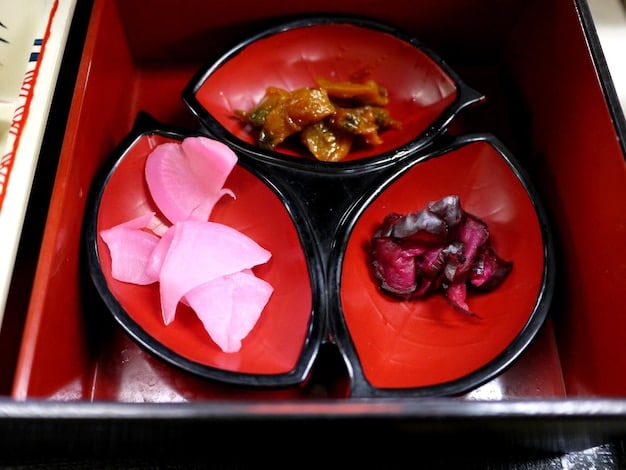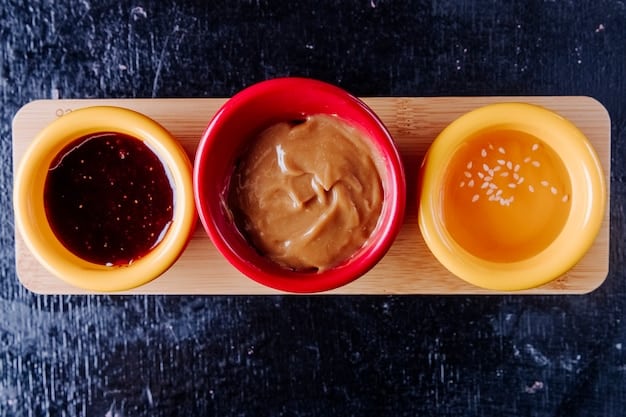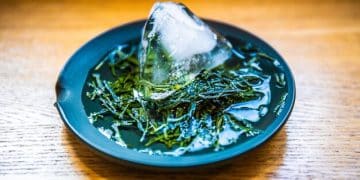Beyond Soy Sauce: Your Guide to Japanese Condiments in 2025

Beyond Soy Sauce: Mastering Japanese Condiments for Authentic Flavor in 2025 involves exploring a diverse range of seasonings like miso, mirin, sake, dashi, and various vinegars, essential for creating authentic and flavorful Japanese dishes, enhancing your culinary skills and offering diverse tastes.
Are you ready to elevate your Japanese cooking beyond the familiar taste of soy sauce? Beyond Soy Sauce: Mastering Japanese Condiments for Authentic Flavor in 2025 is your passport to a world of umami, sweetness, acidity, and depth that will transform your dishes from simple to spectacular.
Exploring the World of Japanese Condiments
Japanese cuisine is renowned for its delicate balance of flavors and its reliance on high-quality ingredients. While soy sauce is a foundational element, the true depth and complexity of Japanese dishes come from a wider arsenal of condiments. These seasonings, often fermented and meticulously crafted, add nuances that elevate the entire culinary experience.
Understanding and mastering these condiments is key to recreating authentic Japanese flavors in your own kitchen. Let’s delve into some essential Japanese condiments that go beyond soy sauce.
Miso: A Fermented Soybean Paste
Miso is a traditional Japanese seasoning produced by fermenting soybeans with koji (a type of mold), salt, and sometimes rice, barley, or rye. The fermentation process yields a paste with a complex, savory, and slightly sweet flavor profile.
There are numerous varieties of miso, each with distinct characteristics. Here are a few popular types:
- Shiro Miso (White Miso): Light in color and flavor, made with a higher ratio of rice koji. Ideal for soups, dressings, and marinades.
- Aka Miso (Red Miso): Fermented longer, resulting in a darker color and bolder, more intense flavor. Excellent for hearty stews and glazes.
- Awase Miso (Mixed Miso): A blend of different miso varieties, providing a balanced flavor profile suitable for various dishes.
- Hatcho Miso (Soybean Miso): Made purely from soybeans, offering a rich, umami-packed flavor. Often used in vegetarian and vegan dishes.
Miso is not only a flavor enhancer but also a source of beneficial probiotics. Experimenting with different types of miso will unlock new dimensions in your cooking.
In conclusion, miso adds great flavour to many Japanese recipes.
Mirin: The Sweet Rice Wine
Mirin is a sweet Japanese rice wine similar to sake but with a lower alcohol content and higher sugar concentration. It is made by fermenting glutinous rice and koji. Mirin provides a delicate sweetness, a subtle complexity, and a glossy finish to Japanese dishes.
Mirin is indispensable in teriyaki sauces, simmered dishes (nimono), and noodle broths. It balances salty flavors and enhances the overall taste profile.
True Mirin vs. Aji-Mirin
It’s important to distinguish between hon-mirin (true mirin) and aji-mirin (mirin-like seasoning). Hon-mirin is made using traditional methods and contains about 14% alcohol, while aji-mirin is a commercially produced substitute with added sugars and flavorings. Try to buy Hon-Mirin for the best authentic result.
Mirin adds a sweet flavour and glossy finish to recipes.

Sake: The Versatile Rice Wine
Sake, often referred to as rice wine, is made by fermenting rice. It’s not only a popular beverage but also a versatile cooking ingredient in Japanese cuisine. Sake adds depth, aroma, and subtle sweetness to dishes, and it helps tenderize meats.
Different grades of sake can be used in cooking, from junmai (pure rice sake) to futsu-shu (table sake). Sake can be used in marinades, sauces, and braising liquids.
Cooking with Sake: Tips and Techniques
When cooking with sake, consider the following tips to maximize its flavor-enhancing properties:
- Deglazing: Use sake to deglaze pans after searing meat or vegetables to capture flavorful caramelized bits.
- Marinades: Sake helps tenderize and flavor proteins, making it a great addition to marinades.
- Simmering: Add sake to simmering liquids for a touch of sweetness and umami. It’s especially great when making broth.
Sake is the perfect alcoholic touch to marinades and simmered dishes.
Dashi: The Foundation of Japanese Broth
Dashi is the fundamental broth in Japanese cuisine, providing a savory and umami-rich base for soups, sauces, and simmered dishes. It is typically made from kombu (dried kelp) and katsuobushi (dried bonito flakes), although variations exist using shiitake mushrooms or dried sardines.
Dashi provides depth of flavour and is the cornerstone of many dishes.
Making Dashi at Home: A Simple Guide
Making dashi at home is surprisingly easy. Here’s a basic recipe:
- Soak a piece of kombu in water for at least 30 minutes.
- Gently heat the water until it’s just about to simmer, then remove the kombu.
- Add katsuobushi to the hot water and let it steep for a few minutes.
- Strain the broth through a fine-mesh sieve.
The resulting dashi can be used immediately or stored in the refrigerator for a few days.
Japanese Vinegars: A Spectrum of Acidity
Japanese vinegars are used for their delicate acidity and subtle sweetness. They are made from rice and are less harsh than Western vinegars. Rice vinegar is a key component in sushi rice, dressings, and marinades.
There are several types of Japanese rice vinegar, including:
- Komezu (Rice Vinegar): The most common type, with a mild and slightly sweet flavor.
- Aka-zu (Red Vinegar): Made from sake lees (the sediment left over after sake production), offering a richer, more complex flavor.
- Kurozu (Black Vinegar): Aged rice vinegar with a dark color and a mellow, slightly smoky flavor.
Choose the right vinegar to enhance the flavors in your dish.
Other Essential Japanese Condiments
Beyond the aforementioned condiments, several other seasonings play important roles in Japanese cuisine. These include:

Sesame Oil: Aromatic and Flavorful
Toasted sesame oil adds nutty aroma, and distinctive flavor to dishes. Sesame oil is often used in stir-fries, marinades and as a finishing oil.
Ponzu: Citrus-Infused Soy Sauce
Ponzu is a citrus-based sauce, typically made with soy sauce, citrus juice (such as yuzu or lemon), mirin, and vinegar. It’s a refreshing dipping sauce for grilled meats, seafood, and tofu.
Rayu (Japanese Chili Oil): Adds spice!
Rayu is a spicy chili oil infused with various aromatics like garlic, ginger, and sesame seeds. It adds heat, depth, and a pleasant aroma to dishes.
Furikake: A Flavorful Rice Topping
Furikake is a dry Japanese seasoning meant to be sprinkled on top of cooked rice. It typically contains a mixture of dried fish, sesame seeds, seaweed, sugar, and salt. It’s a quick and easy way to add flavor and texture to simple rice dishes.
There are many Japanese must have condiments that can be experimented with.
| Key Point | Brief Description |
|---|---|
| 🍚 Miso | Fermented soybean paste enhancing umami in soups and marinades. |
| 🍶 Mirin | Sweet rice wine adding sweetness and gloss to dishes. |
| 🍲 Dashi | Broth made from kombu and katsuobushi, the foundation of many dishes. |
| 🌶️ Rayu | Spicy chili oil enhancing dishes with heat and aroma. |
Frequently Asked Questions
▼
Soy sauce is made from soybeans, wheat, salt, and water, while tamari is typically made with little to no wheat. This makes tamari a popular gluten-free alternative with a richer and more intense flavor than regular soy sauce.
▼
Miso can be used to add flavor to soups, marinades, glazes, and dressings. It’s best to dissolve miso in a bit of warm water before adding it to a recipe to ensure it blends well.
▼
Mirin should be stored in a cool, dark place away from direct sunlight. Once opened, it’s best to refrigerate mirin to maintain its flavor and prevent it from oxidizing.
▼
If you don’t have sake on hand, you can substitute it with dry sherry or Chinese rice wine. Alternatively, you can use a mixture of rice vinegar and water with a pinch of sugar to mimic the sweetness of sake.
▼
Furikake is typically sprinkled over cooked rice as a seasoning. It can also be used to add flavor and texture to other dishes, such as noodles, salads, and even popcorn. You can also use is in bento boxes.
Conclusion
Unlocking the authentic flavors of Japanese cuisine involves venturing beyond soy sauce and exploring the rich tapestry of Japanese condiments. By mastering the art of using miso, mirin, sake, dashi, and other essential seasonings, you can transform your cooking and create dishes that are both delicious and deeply satisfying. Embrace the culinary journey, and savor the authentic tastes of Japan in 2025!





